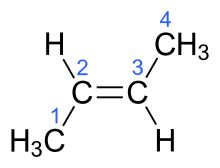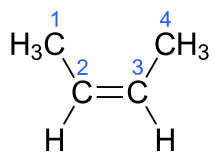E-Z notation
E-Z configuration, or the E-Z convention, is the IUPAC preferred method of describing the absolute stereochemistry of double bonds in organic chemistry. It is an extension of cis/trans notation (which only describes relative stereochemistry) that can be used to describe double bonds having two, three or four substituents.
Following the Cahn–Ingold–Prelog priority rules, each substituent on a double bond is assigned a priority.
If the two groups of higher priority are on opposite sides of the double bond, the bond is assigned the configuration E (from entgegen, German: [ɛntˈɡeːɡən], the German word for "opposite").
If the two groups of higher priority are on the same side of the double bond, the bond is assigned the configuration Z (from zusammen, German: [tsuˈzamən], the German word for "together").
 |
 | |
| (E)-But-2-ene | (Z)-But-2-ene |
The letters E and Z are conventionally printed in italic type, within parentheses, and separated from the rest of the name with a hyphen. They are always printed as full capitals (not in lowercase or small capitals), but do not constitute the first letter of the name for English capitalization rules (as in the example above).
For organic molecules with multiple alkenes, it is sometimes necessary to indicate the alkene location for each E or Z symbol. For example, the chemical name of alitretinoin is (2E,4E,6Z,8E)-3,7-dimethyl-9-(2,6,6-trimethyl-1-cyclohexenyl)nona-2,4,6,8-tetraenoic acid, indicating that the alkenes starting at positions 2, 4, and 8 are E while the one starting at position 6 is Z.
See also
References
- Panico R, Powell WH, Richer JC, eds. (1993). "Recommendation 7.1.2". A Guide to IUPAC Nomenclature of Organic Compounds. IUPAC/Blackwell Science. ISBN 0-632-03488-2.